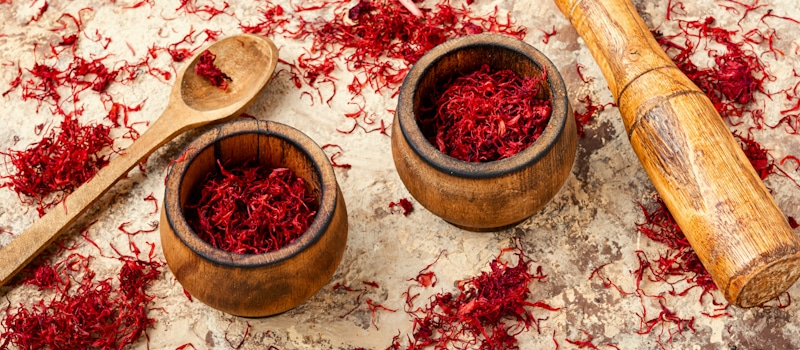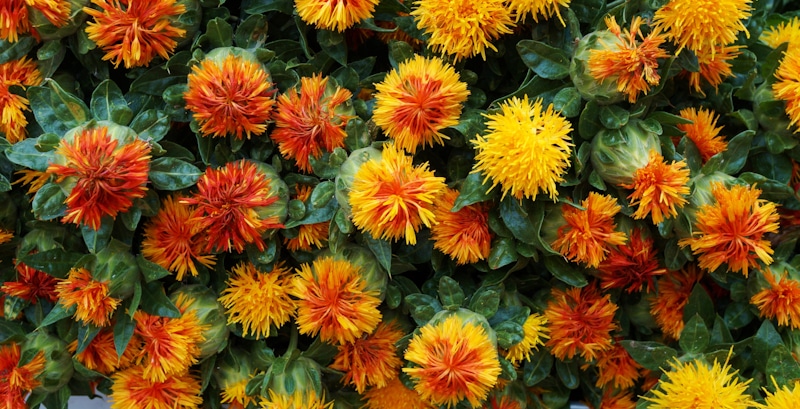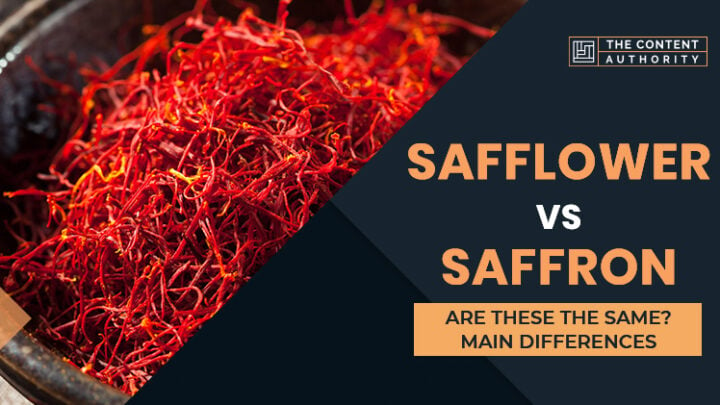Spices not only serve to awaken the taste buds. They also contain an endless list of nutrients, essential oils, antioxidants, minerals, and vitamins that are vital for the well-being of our bodies. Today, we will clarify whether saffron and safflower are the same spice with a different name among the wonderful spices available.
Saffron and safflower are two different spices. Saffron is a spice with a powerful and particular flavor, while safflower offers a much milder flavor. To spice up a dish, you only need a pinch of saffron. But if you want to do the same with safflower, you will need to add large amounts.
In addition to the use of spices in cooking, they also have many chemical compounds of plant origin that people attribute to them as disease-preventive properties. Spices have been with us for centuries, and today they are even more important for human beings. We will study saffron and safflower, their differences, origins, uses, and much more in this opportunity. We enthusiastically invite you to continue reading.

What Is Saffron?
Saffron is a spice composed of fine stamens that provides a beautiful golden color and an aromatic and spicy flavor to foods. You can buy this spice in golden-red strands or ground, and fortunately, it is available all year round.
It is essential to know that saffron is the most expensive spice in the world. The reason for its cost is that each strand of saffron is that workers must extract it by hand, which means that more than 70,000 saffron flowers are needed to obtain one pound of saffron. People have used saffron for centuries in Persian, Arabic, European and Indian food.
Saffron is a spice that we can obtain from the stigmas of the autumn plant Crocus Sativus, which comes from the lily family. The origin of saffron is Asia Minor. For thousands of years, people have used it for medicines, perfumes, dyes, and food and beverage flavorings in that region. Commercially cultivating saffron countries are Spain, Greece, Turkey, India, France, Italy, and China.
What Is The Origination Of The Word “Saffron”?
The word saffron comes directly from the Latin “safranum,” through the Old French term “safran” from the 12th century. The Old French, in turn, took it from the Arabic “za’faran” and also from the Persian “zarparán,” meaning “golden leaves.”
The Latin form “safranum” is the source of the Catalan “safrá” and the Italian “zafferano”; however, the Portuguese “acafrao” and the Spanish “azafrán” come from the Arabic “az-zaferán.”
What Is The Safflower?
The safflower, Carthamus Tinctorius, is an annual flowering, highly branched, herbaceous, thistle-like plant. It is a commercially cultivated spice for vegetable oil that workers can extract from its seeds. Early Spanish colonies along the Rio Grande used safflower as a substitute for saffron.
Safflower, like saffron, has utility as a fabric dye, such as for food coloring. As a culinary spice, people use flower petals. People also add pinches of this spice in soups, stews, rice dishes, and beverages such as tisane.
The safflower comes from the Asteraceae family, native to Asia and Africa, central India to the Nile River, and as far north as Ethiopia. The safflower plant grows from 0.3 to 1.2 meters tall and has flowers that can be red, orange, yellow, or white.
What Is The Origin Of The Word “Safflower”?
The generic botanical name of safflower is Carthamus, which derives from the Arabic verb “qurtum” meaning dye. This verb refers to the use of safflower flowers for textile dyeing. The word also entered some Romance languages, such as Italian “cartamo” or Catalan “cártam,” probably through Spanish “cártamo,” and Turkish “kartam.”
The modern Arabic name for safflower, “al-usfur,” comes from the adjective “asfar,” meaning “yellow.” Interestingly, the Arabic “usfur” is also the source of the name safflower in several European languages, for example, German “saflor,” Finnish “saflori,” and Bulgarian and Russian “saflor.”
These names come from “usfur” or “asfur” through the Old Italian “asfiore or saffiore” and the Old French “saffleur.” Thanks to popular etymology, people transformed the name into saffron and flower.
What Are The Differences Between “Saffron” And “Safflower”?
Here are the main differences between saffron and safflower.
| Characteristics | Saffron | Safflower |
| Color | Much more delicate and subdued color | Bright red color |
| Appearance | Saffron is composed of stamens | Safflower is composed of red, orange, yellow, or white flowers |
| Coloring capacity | Small quantity to achieve an intense yellow color in foodstuffs | Too much quantity to get a yellow color in food |
| Flavor | It has an intense and robust flavor. Its taste is similar to honey with a touch of spiciness | It has a very mild or imperceptible flavor. Its taste is similar to specific notes of sweet chocolate |
| Primary use | Flavoring and food coloring | As vegetable oil for cooking and food coloring |
| Price | It is the most expensive spice in the world | It is a very economical spice |
How Do People Use The Word “Saffron”?
Here we will review some of the uses people give to saffron.
Saffron As An Effective Antioxidant
Saffron contains many plant compounds that work as antioxidants or molecules that help protect cells from free radicals.
Among the antioxidants in saffron are crocin, crocetin, safranal, and kaempferol. Crocin and crocetin are responsible for saffron’s red color.
Saffron As An Antidepressant
Saffron also has the nickname “sun spice.” The reason for this nickname is because it can help improve mood. In several studies, scientists found that saffron supplements were more effective than other options in treating mild to moderate depression symptoms. However, these studies are still under review, as scientifically, it is still premature to say that saffron is a certified treatment for depression.
Some People Attribute Cancer-fighting Properties To Saffron
In some test studies, experts found that saffron and its compounds randomly killed some types of cancer cells or slowed their growth without affecting normal cells. Research is still ongoing and is not yet conclusive.
Saffron May Reduce Premenstrual Syndrome Symptoms
Several studies show that saffron helps to treat the symptoms of premenstrual syndrome. One of the results of these studies indicates that some women who took 30 mg of saffron a day had a more effective reduction of symptoms than with other products.

How Do People Use The Word “Safflower”?
Now, we will have the opportunity to review some of the uses people give to safflower.
Safflower As A Cooking Oil
You can find safflower oil in two versions. The monounsaturated version is odorless and colorless. It has a reasonably high combustion point, which is ideal for frying food at high temperatures. The polyunsaturated presentation is much more delicate than its other variety.
Safflower As A Substitute For Saffron
The safflower is the popular substitute for saffron; for this reason, people also call it the poor man’s saffron, the bastard saffron, or the false saffron.
Safflower As Tea
A practical way to consume the safflower is to soak its petals in hot water to prepare an infusion. As infusion safflower has multiple health benefits, among them is improving bone and cardiovascular health.
Safflower As Anti-inflammatory
Safflower oil may have anti-inflammatory properties. According to a Clinical Nutrition study, safflower oil and its unsaturated fatty acids improve markers of inflammation. This fact may help other pathologies such as diabetes and heart disease.
Examples Of The Use Of The Words In Everyday Sentences
Now let’s take a look at some examples of saffron and safflower in everyday sentences.
Examples With Saffron
- My grandmother prepares a medicine with saffron that helps you to lift your spirits.
- I couldn’t get saffron at the usual store; they told me they’re getting it next week.
- A good saffron meal is what I would need today when I get home.
Examples With Safflower
- If you want something practical for your cough, make yourself a safflower tea.
- I couldn’t afford saffron, but I bought safflower, which is much cheaper.
- Instead of using canola oil, I recommend that you pre-pour safflower oil; it is much healthier.
A Final Thought On Saffron And Safflower
Spices like saffron and safflower contain many minerals such as potassium, manganese, iron, and other vitamins. Both saffron and safflower provide multiple benefits.
They are options that work for all tastes and pockets. But what is essential is that no matter which one you choose, both spices are tremendously healthy for humans.
Shawn Manaher is the founder and CEO of The Content Authority. He’s one part content manager, one part writing ninja organizer, and two parts leader of top content creators. You don’t even want to know what he calls pancakes.

